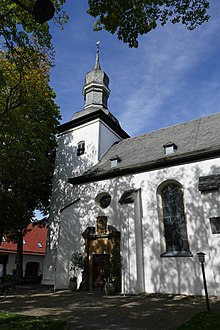St. Antonius of Padua (Bad Wünnenberg)
The Catholic parish church of St. Antonius is a listed church building in Bad Wünnenberg , a town in the Paderborn district ( North Rhine-Westphalia ).
History and architecture
prehistory
The previous church, probably a half-timbered church , burned down with the town in 1677.
The community was probably built between 850 and 900. At that time, St. Meinolf brought the relics of St. Liborius from Le Mans to Paderborn and the population began to be baptized. However, a previous church was not mentioned in a document until 1182. It did not stand at this point, but in Eddinghausen . She was subordinate to the Patronage of the Immaculate Conception of Mary and the Apostles Jude and Simon. The remains of the rubble have been preserved. Around 1300 Eddinghausen had to give up his church and was assigned to the city of Wünnenberg.
Today's church
The plastered hall structure of three bays , with a choir closed on three sides , stands in the upper town. It was built from 1678 to 1679 from quarry stone that was plastered. The west tower with a high, curved hood is presented. The church is crowned with a cross and a weathercock . A sacristy was added in 1929. The church was extended to the north in 1977, an annex opened to the altar was built. On the south side there is a column portal made of sandstone , it bears the designation 1678 and a coat of arms of the Paderborn prince-bishop von Fürstenberg. An inscription reminiscent of a city fire is also attached. The translated inscription reads: God. The Almighty - the Most High - Sanctified - Ferdinand, by the grace of God, Bishop of Paderborn, Coadjutor of Munster, Prince of the Holy Roman Empire, Duke of Pyrmont and Baron von Fürstenberg, has remembered the benefactions, this church dedicated to St. Anthony of Padua, who confessed that the old church was devastated by a sudden fire at the same time as the whole city, was built from the ground up. Anno M DC LXXVIII = 1678 . An arched window is let into the portal . The groin vaults in the interior rest on flat wall templates, the keystones bear the coat of arms of the von Fürstenberg family. The walls of the old building are divided by arched windows, in the new building there are artist windows with depictions from the life of St. Anthony of Padua.
Furnishing
- The painting in a wood-carved frame from 1680 in the neo-baroque high altar from 1934 shows the offering in the temple, it is attributed to Johann Georg Rudolphi .
- A richly carved former communion bench is marked 1724, it is integrated into the front prayer bench.
- The wooden figures of Saints Boniface, Liborius and Antonius were created around 1720.
- The organ's oldest pipes date from around 1678.
- The remarkable font is from the 18th century.
- The Radiant Madonna probably originally came from Dalheim Monastery , it was installed in the church after the Second World War .
- The sundial from 1720 shows the hour of the day and the season. The artfully crafted work on a slate bears the inscription: A solis ortu usque ad occasum laudabile nomen domini (From the rising of the sun to its setting, the name of the Lord be praised!)
- Five bronze bells with the tone sequence c'-es'-f'-as'-b '. Bells II and III were cast in special bronze from Brilon in 1946. Bell I was made in 1947 in special bronze from Brilon. Bell IV was cast by Heinrich Humpert in Brilon in 1922 and in 1962 Petit & Edelbrock supplied the bell V.
literature
- Ursula Quednau (arrangement): Dehio-Handbuch der Deutschen Kunstdenkmäler, North Rhine-Westphalia, Volume II: Westphalia. Deutscher Kunstverlag , Berlin / Munich 2011, ISBN 978-3-422-03114-2 , p. 83.
Web links
- History and photos (accessed March 13, 2012)
- History of the previous church (accessed on March 13, 2012)
Individual evidence
- ↑ unproven assumption by the parish
- ↑ Prehistory and current photo, accessed on March 13, 2012
- ↑ Ursula Quednau (arrangement): Dehio-Handbuch der Deutschen Kunstdenkmäler, North Rhine-Westphalia, Volume II: Westphalia. Deutscher Kunstverlag, Berlin / Munich 2011, ISBN 978-3-422-03114-2 , p. 83.
- ^ History
Coordinates: 51 ° 31 ′ 4.8 ″ N , 8 ° 41 ′ 48 ″ E


